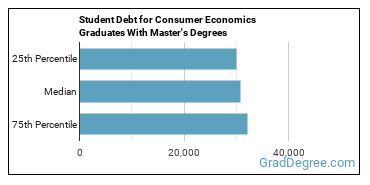Master’s Degrees in Family & Consumer Economics
Featured schools near , edit
Education Levels of Consumer Economics Majors
During the most recent year for which data is available, 182 people earned their master's degree in consumer economics. This makes it the 207th most popular master's degree program in the country.
The following table shows the number of diplomas awarded in consumer economics at each degree level.
| Education Level | Number of Grads |
|---|---|
| Master’s Degree | 182 |
| Graduate Certificate | 68 |
| Doctor’s Degree | 8 |
Earnings of Consumer Economics Majors With Master’s Degrees
The median salary for graduates holding a master's degree in consumer economics is $40,368. However, this can depend on a number of factors, such as where you live and the number of years experience you have. To get a better picture, earnings for this category of people can range from a low of $39,813 to a high of $46,058.

Student Debt
The median student debt for graduates holding a master's degree in consumer economics is $30,492. The school you go to and how long it takes you to graduate, among other things, can cause this number to vary. The chart below shows the range of accumulated debt loads. On the high side of the range, $35,340 is the debt load, and the debt load on the low side is $24,784.

Student Diversity
More women than men pursue their master's degree in consumer economics. About 74.2% of graduates with this degree are female.
| Gender | Number of Grads |
|---|---|
| Men | 47 |
| Women | 135 |

The racial-ethnic distribution of consumer economics master’s degree students is as follows:
| Race/Ethnicity | Number of Grads |
|---|---|
| Asian | 6 |
| Black or African American | 15 |
| Hispanic or Latino | 47 |
| White | 92 |
| International Students | 8 |
| Other Races/Ethnicities | 14 |

Most Popular Consumer Economics Programs for Master’s Degrees
There are 9 colleges that offer a master’s degree in consumer economics. Learn more about the most popular 9 below:
Arizona State University - Skysong tops the list of the most popular school in the U.S. for consumer economics majors who are seeking their master's degree. Roughly 53,900 attend the school each year. The average in-state tuition for full-time undergraduates is $10,978 per year, while in-state graduate students, on average, pay $9,972 per year. During the most recent year for which we have data, 93 people received their master's degree in consumer economics from ASU - Skysong. About 93% of this group were women, and 44% were students from an underrepresented racial-ethnic group.
Texas Tech University is the 2nd most popular school in the nation for students seeking a master's degree in consumer economics. Roughly 40,300 attend the school each year. The average in-state tuition for full-time undergraduates is $8,935 per year, while in-state graduate students, on average, pay $6,956 per year. During the most recent year for which we have data, 59 people received their master's degree in consumer economics from Texas Tech. About 33% of this group were women, and 40% were students from an underrepresented racial-ethnic group.
The University of Alabama is the 3rd most popular school in the nation for students seeking a master's degree in consumer economics. Roughly 37,800 attend the school each year. The average in-state tuition for full-time undergraduates is $11,100 per year, while in-state graduate students, on average, pay $11,100 per year. During the most recent year for which we have data, 31 people received their master's degree in consumer economics from UA. Around 20% of these students were from an underrepresented racial-ethnic group, and 56% were women.
New Mexico State University - Main Campus comes in at #4 on our list of the most popular colleges offering master's degrees in consumer economics. The average in-state tuition for full-time undergraduates is $6,283 per year, while in-state graduate students, on average, pay $5,184 per year. During the most recent year for which we have data, 16 people received their master's degree in consumer economics from NMSU Main Campus. About 100% of this group were women, and 63% were students from an underrepresented racial-ethnic group.
South Dakota State University comes in at #5 on our list of the most popular colleges offering master's degrees in consumer economics. The average in-state tuition for full-time undergraduates is $7,773 per year, while in-state graduate students, on average, pay $8,164 per year. During the most recent year for which we have data, 2 people received their master's degree in consumer economics from South Dakota State.
University of Arizona comes in at #7 on our list of the most popular colleges offering master's degrees in consumer economics. The average in-state tuition for full-time undergraduates is $11,210 per year, while in-state graduate students, on average, pay $12,348 per year. During the most recent year for which we have data, 1 people received their master's degree in consumer economics from University of Arizona. Of these students, 100% were women and 75% were members of underrepresented racial-ethnic groups.
University of Minnesota - Twin Cities comes in at #7 on our list of the most popular colleges offering master's degrees in consumer economics. Roughly 52,000 attend the school each year. The average in-state tuition for full-time undergraduates is $14,006 per year, while in-state graduate students, on average, pay $18,468 per year. During the most recent year for which we have data, 1 people received their master's degree in consumer economics from UMN Twin Cities. About 50% of this group were women, and 100% were students from an underrepresented racial-ethnic group.
Consumer Economics Concentrations
| Major | Annual Degrees Awarded |
|---|---|
| 179 | |
| 2 | |
| 1 |
Explore Major by State
Alabama
Arkansas
Connecticut
Florida
Idaho
Iowa
Louisiana
Massachusetts
Mississippi
Nebraska
New Jersey
North Carolina
Oklahoma
Rhode Island
Tennessee
Vermont
West Virginia
Related Majors
Below are some popular majors that are similar to consumer economics that offer master’s degrees.
| Major | Annual Degrees Awarded |
|---|---|
| 1,253 | |
| 1,047 | |
| 264 | |
| 110 | |
| 54 |
References
*The racial-ethnic minority student count is calculated by taking the total number of students and subtracting white students, international students, and students whose race/ethnicity was unknown. This number is then divided by the total number of students at the school to obtain the percentage of racial-ethnic minorities.
More about our data sources and methodologies.
Featured Schools
 Request Info
Request Info
|
Southern New Hampshire University You have goals. Southern New Hampshire University can help you get there. Whether you need a bachelor's degree to get into a career or want a master's degree to move up in your current career, SNHU has an online program for you. Find your degree from over 200 online programs. Learn More > |







